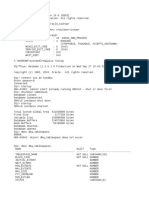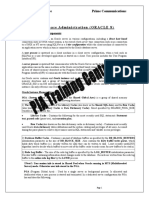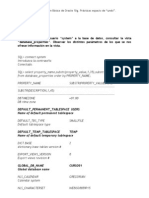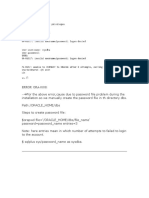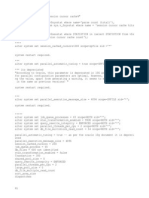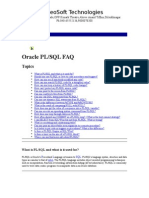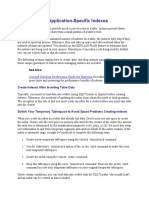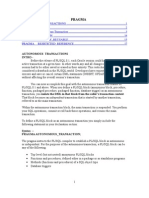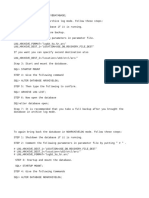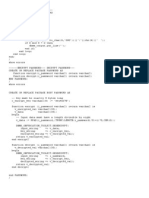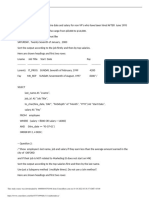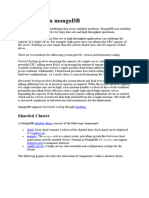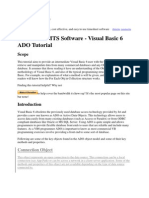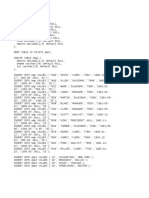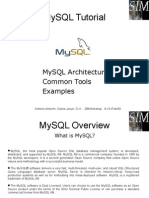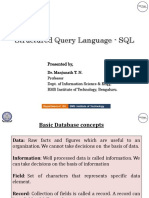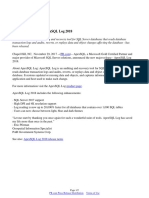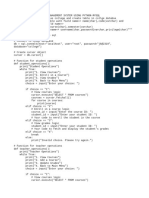Top tips for Oracle SQL
tuning
BUY
GUYS
BUY
BUY QUEST
QUEST
PRODUCTS
PRODUCTS
BOOK
Guy Harrison
Senior Software Architect,
Quest Software
�Top 10 Oracle SQL tuning tips
1.
2.
3.
4.
5.
6.
7.
8.
9.
10.
Design and develop with performance in mind
Establish a tuning environment
Index wisely
Reduce parsing
Take advantage of Cost Based Optimizer
Avoid accidental table scans
Optimize necessary table scans
Optimize joins
Use array processing
Consider PL/SQL for tricky SQL
�Hint #1: Design and develop with
performance in mind
Explicitly identify performance targets
Focus on critical transactions
Test the SQL for these transactions against simulations of production
data
Measure performance as early as possible
Consider prototyping critical portions of the applications
Consider de-normalization and other performance by design
features early on
�Hint #2: Establish a tuning and
development environment
A significant portion of SQL that performs poorly in production
was originally crafted against empty or nearly empty tables.
Make sure you establish a reasonable sub-set of production
data that is used during development and tuning of SQL
Make sure your developers understand EXPLAIN PLAN and
tkprof, or equip them with commercial tuning tools.
�Understanding SQL tuning tools
The foundation tools for SQL tuning are:
The EXPLAIN PLAN command
The SQL Trace facility
The tkprof trace file formatter
Effective SQL tuning requires either familiarity with
these tools or the use of commercial alternatives such
as SQLab
�EXPLAIN PLAN
The EXPLAIN PLAN reveals the execution plan for an SQL
statement.
The execution plan reveals the exact sequence of steps that
the Oracle optimizer has chosen to employ to process the SQL.
The execution plan is stored in an Oracle table called the plan
table
Suitably formatted queries can be used to extract the execution
plan from the plan table.
�A simple EXPLAIN PLAN
SQL> EXPLAIN PLAN FOR select count(*) from sales
where product_id=1;
Explained.
SQL> SELECT RTRIM (LPAD (' ', 2 * LEVEL) || RTRIM (operation)
||' '||RTRIM (options) || ' ' || object_name) query_plan
2
FROM plan_table
3
CONNECT BY PRIOR id = parent_id
4*
START WITH id = 0
QUERY_PLAN
-------------------------------------------SELECT STATEMENT
SORT AGGREGATE
TABLE ACCESS FULL SALES
�Interpreting EXPLAIN PLAN
The more heavily indented an access path is, the
earlier it is executed.
If two steps are indented at the same level, the
uppermost statement is executed first.
Some access paths are joined such as an index
access that is followed by a table lookup.
�A more complex EXPLAIN PLAN
SELECT STATEMENT
VIEW SYS_DBA_SEGS
UNION-ALL
NESTED LOOPS
NESTED LOOPS
NESTED LOOPS
NESTED LOOPS
NESTED LOOPS
VIEW SYS_OBJECTS
UNION-ALL
TABLE ACCESS FULL TAB$
TABLE ACCESS FULL TABPART$
TABLE ACCESS FULL CLU$
TABLE ACCESS FULL IND$
TABLE ACCESS FULL INDPART$
TABLE ACCESS FULL LOB$
TABLE ACCESS FULL TABSUBPART$
TABLE ACCESS FULL INDSUBPART$
TABLE ACCESS FULL LOBFRAG$
TABLE ACCESS BY INDEX ROWID OBJ$
INDEX UNIQUE SCAN I_OBJ1
TABLE ACCESS CLUSTER SEG$
INDEX UNIQUE SCAN I_FILE#_BLOCK#
TABLE ACCESS BY INDEX ROWID FILE$
INDEX UNIQUE SCAN I_FILE2
TABLE ACCESS CLUSTER TS$
INDEX UNIQUE SCAN I_TS#
TABLE ACCESS CLUSTER USER$
INDEX UNIQUE SCAN I_USER#
NESTED LOOPS
NESTED LOOPS
NESTED LOOPS
NESTED LOOPS
TABLE ACCESS FULL UNDO$
TABLE ACCESS BY INDEX ROWID FILE$
INDEX UNIQUE SCAN I_FILE2
TABLE ACCESS CLUSTER SEG$
INDEX UNIQUE SCAN I_FILE#_BLOCK#
TABLE ACCESS CLUSTER TS$
INDEX UNIQUE SCAN I_TS#
TABLE ACCESS CLUSTER USER$
INDEX UNIQUE SCAN I_USER#
NESTED LOOPS
NESTED LOOPS
NESTED LOOPS
TABLE ACCESS FULL FILE$
TABLE ACCESS CLUSTER SEG$
INDEX RANGE SCAN I_FILE#_BLOCK#
TABLE ACCESS CLUSTER TS$
INDEX UNIQUE SCAN I_TS#
TABLE ACCESS CLUSTER USER$
INDEX UNIQUE SCAN I_USER#
�SQL_TRACE and tkprof
ALTER SESSION SET SQL_TRACE TRUE causes a trace of
SQL execution to be generated.
The TKPROF utility formats the resulting output.
Tkprof output contains breakdown of execution statistics,
execution plan and rows returned for each step. These stats
are not available from any other source.
Tkprof is the most powerful tool, but requires a significant
learning curve.
�Tkprof output
count2
------ -----Parsea
1d
Executeb
1e
Fetchc
20j
------ -----total
22
cpu3 elapsed4
disk5
query6 current7
------ -------- ------- -------- -------0.02
0.01
0
0
0
0.00
0.00
0
0
0
141.10
141.65
1237 1450011
386332
------ -------- ------- -------- -------141.12
141.66
1237k 1450011f 386332g
rows8
-----0
0
99i
-----99h
Rowsl
Execution Planm
------- --------------------------------------------------0 SELECT STATEMENT
GOAL: CHOOSE
99
FILTER
96681
TABLE ACCESS
GOAL: ANALYZED (FULL) OF 'CUSTOMERS'
96582
TABLE ACCESS
GOAL: ANALYZED (FULL) OF 'EMPLOYEES'
�Using SQLab
Because EXPLAIN PLAN and tkprof are unwieldy and hard to
interpret, third party tools that automate the process and
provide expert advice improve SQL tuning efficiency.
The Quest SQLab product:
Identifies SQL your database that could benefit from tuning
Provides a sophisticated tuning environment to examine, compare and
evaluate execution plans.
Incorporates an expert system to advise on indexing and SQL
statement changes
�SQLab SQL tuning lab
Display execution plan in a variety of intuitive ways
Provide easy access to statistics and other useful data
Model changes to SQL and immediately see the results
�SQLab Expert Advice
SQLab provides specific advice on how to tune an SQL
statement
�SQLab SQL trace integration
SQLab can also retrieve the execution statistics that are otherwise only
available through tkprof
�Hint #3: Index wisely
Index to support selective WHERE clauses and join conditions
Use concatenated indexes where appropriate
Consider overindexing to avoid table lookups
Consider advanced indexing options
Hash Clusters
Bit mapped indexes
Index only tables
�Effect of adding columns to a
concatenated index
Novice SQL programmers often are satisfied if the
execution plan shows an index
Make sure the index has all the columns required
700
Surname index only
40
Merge 3 indexes
20
Index on Surname+f irstname
Index on
Surname+f irstname+DOB
Index on
Surname+f irstname+dob+phoneo
100
200
300
400
Logical IO
500
600
700
800
�Bit-map indexes
Contrary to widespread belief, can be effective when there
are many distinct column values
Not suitable for OLTP however
E la p s e d tim e ( s )
100
10
0.1
0.01
1
10
100
1,000
10,000
100,000
1,000,000
Distinct values
Bitmap index
B*-Tree index
Full table scan
�Hint #4: Reduce parsing
Use bind variables
Bind variables are key to application scalability
If necessary in 8.1.6+, set cursor CURSOR_SHARING to
FORCE
Reuse cursors in your application code
How to do this depends on your development language
Use a cursor cache
Setting SESSION_CACHED_CURSORS (to 20 or so) can
help applications that are not re-using cursors
�Hint #5: Take advantage of the Cost
Based Optimizer
The older rule based optimizer is inferior in almost
every respect to the modern cost based optimizer
Using the cost based optimizer effectively involves:
Regular collection of table statistics using the ANALYZE or
DBMS_STATS command
Understand hints and how they can be used to influence
SQL statement execution
Choose the appropriate optimizer mode: FIRST_ROWS is
best for OLTP applications; ALL_ROWS suits reporting and
OLAP jobs
�Hint #6: Avoid accidental tablescans
Tablescans that occur unintentionally are a major
source of poorly performing SQL. Causes include:
Missing Index
Using !=, <> or NOT
Use inclusive range conditions or IN lists
Looking for values that are NULL
Use NOT NULL values with a default value
Using functions on indexed columns
Use functional indexes in Oracle8i
�Hint #7: Optimize necessary table
scans
There are many occasions where a table scan is the only option.
If so:
Consider parallel query option
Try to reduce size of the table
Adjust PCTFREE and PCTUSED
Relocate infrequently used long columns or BLOBs
Rebuild when necessary to reduce the high water mark
Improve the caching of the table
Use the CACHE hint or table property
Implement KEEP and RECYCLE pools
Partition the table (if you really seek a large subset of data)
Consider the fast full index scan
�Fast full index scan performance
Use when you must read every row, but not every column
Counting the rows in a table is a perfect example
19.83
Index range scan (RULE)
17.76
Full index scan
12.53
Full table scan
5.23
Parallel table scan
4.94
fast full index
2.44
Parallel fast full index
0
10
Elapsed time (s)
15
20
�Hint #8: Optimize joins
Pick the best join method
Nested loops joins are best for indexed joins of subsets
Hash joins are usually the best choice for big joins
Pick the best join order
Pick the best driving table
Eliminate rows as early as possible in the join order
Optimize special joins when appropriate
STAR joins for data-warehousing applications
STAR_TRANSFORMATION if you have bitmap indexes
ANTI-JOIN methods for NOT IN sub-queries
SEMI-JOIN methods for EXISTS sub-queries
Properly index CONNECT BY hierarchical queries
�Oracle 8 semi-joins
Optimizes queries using EXISTS where there is no
supporting index
No index on employees
select *
from customers c
where exists
(select 1 from employees e
where e.surname=c.contact_surname
and e.firstname=c.contact_firstname
and e.date_of_birth=c.date_of_birth)
�Oracle 8 semi-joins
Without the semi-join or supporting index, queries like
the one on the preceding slide will perform very badly.
Oracle will perform a tablescan of the inner table for
each row retrieved by the outer table
If customers has 100,000 rows, and employees 800
rows then 80 MILLION rows will be processed!
In Oracle7, you should create the index or use an INbased subquery
In Oracle8, the semi-join facility allows the query to be
resolved by a sort-merge or hash join.
�To Use semi-joins
Set ALWAYS_SEMI_JOIN=HASH or MERGE in
INIT.ORA, OR
Use a MERGE_SJ or HASH_SJ hint in the subquery
of the SQL statement
SELECT*
FROMcustomersc
WHEREexists
(select/*+merge_sj*/1
fromemployeese
where.)
�Oracle8 semi-joins
The performance improvements are impressive (note
the logarithmic scale)
1,343.19
EXISTS no semi-join or indexes
31.01
EXISTS no semi-join but with index
6.83
EXISTS - merge semi-join
6.69
IN-based subquery
10
100
Elapsed time (logarithmic scale)
1,000
10,000
�Star Join improvements
A STAR join involves a large FACT table being joined
to a number of smaller dimension tables
�Star Join improvements
The Oracle7 Star join algorithm works well when there is a
concatenated index on all the FACT table columns
But when there are a large number of dimensions, creating
concatenated indexes for all possible queries is impossible.
Oracle8s Star transformation involves re-wording the query
so that it can be supported by combinations of bitmap indexes.
Since bitmap indexes can be efficiently combined, a single
bitmap index on each column can support all possible queries.
�To enable the star transformation
Create bitmap indexes on each of the FACT table
columns which are used in star queries
Make sure that
STAR_TRANSFORMATION_ENABLED is TRUE,
either by changing init.ora or using an ALTER
SESSION statement.
Use the STAR_TRANSFORMATION hint if necessary.
�Drawback of Star transformation
Bitmap indexes reduce concurrency (row-level locking
may break down).
But remember that large number of distinct column
values may not matter
�Star transformation performance
When there is no suitable concatenated index, the
Star transformation results in a significant
improvement
0.35
No suitable concatenated index
9.94
Star_transformation
Star
0.24
Concatenated index
0.01
5
Elapsed time (s)
10
��Hint #9: Use ARRAY processing
Retrieve or insert rows in batches, rather than one at a time.
Methods of doing this are language specific
60
Elaps ed tim e
50
40
30
20
10
0
0
20
40
60
80
100 120 140
160 180 200 220 240
Array size
260 280 300
�Hint #10: Consider PL/SQL for
tricky SQL
With SQL you specify the data you want, not how to
get it. Sometime you need to specifically dictate your
retrieval algorithms.
For example:
Getting the second highest value
Doing lookups on a low-high lookup table
Correlated updates
SQL with multiple complex correlated subqueries
SQL that seems to hard to optimize unless it is broken into
multiple queries linked in PL/SQL
�Oracle8i PL/SQL Improvements
Array processing
NOCOPY
Temporary tables
The profiler
Dynamic SQL
��Bonus hint: When your SQL is
tuned, look to your Oracle
configuration
When SQL is inefficient there is limited benefit in investing in
Oracle server or operating system tuning.
However, once SQL is tuned, the limiting factor for performance
will be Oracle and operating system configuration.
In particular, check for internal Oracle contention that typically
shows up as latch contention or unusual wait conditions (buffer
busy, free buffer, etc)
Third party tools such as Quests Spotlight on Oracle product
can be invaluable
��www.quest.com





